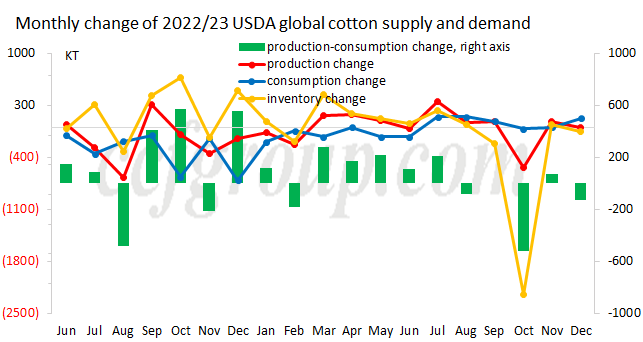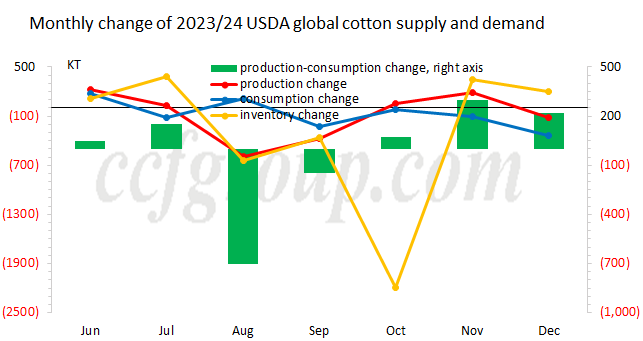Interpretation of USDA's Dec supply and demand report on cotton
The US Department of Agriculture (USDA) recently released the global cotton supply and demand for December, with the main adjustments being made in the consumption. For the 2022/23 marketing year, there were upward revisions in the import and consumption estimates for major cotton-importing countries like Bangladesh, leading to a slight reduction in ending stocks. However, the adjustments for the 2023/24 marketing year leaned towards bearish sentiment. The US cotton production was revised downward again, and there were varying degrees of downward revisions in consumption estimates for the United States, China, and Turkey. Globally, ending stocks increased by 200,000 tons compared to the previous month, but it is still expected to decline over the course of the marketing year.
1. USDA Dec supply and demand
2022/23 marketing year:
- Import estimates were raised by 100,000 tons, mainly due to adjustments for Bangladesh. USDA revised the import figures for Bangladesh for the 2022/23 marketing year after updating the previous year's import data.
- Consumption estimates were increased by 130,000 tons, driven by the upward revision for Bangladesh.
- Ending stocks were reduced by 50,000 metric tons, mainly due to adjustments for Bangladesh.
Overall, global cotton trade and consumption declined compared to the previous year, leading to a buildup of stocks.

2023/24 marketing year:
- Production was revised down by 120,000 tons, with the United States and Turkey reducing production by 70,000 tons each.
- Imports were forecast 30,000 tons lower, as the higher imports in China were basically offset by the reduction in Turkey, Pakistan and Bangladesh.
- Consumption was forecast 340,000 tons lower, with 30,000 tons from United States, 220,000 tons from China and 90,000 tons from Turkey.
The ending stocks were up by 200,000 tons overall.

2. US cotton production:
The USDA's monthly adjustments to US cotton production always attract attention. This month, contrary to expectations based on the previous month's trend, US cotton production was further revised downward. Although the adjustment was not significant, it resulted in historically low production levels. This adjustment is based on lagging inspection data and lower-than-expected delivery rates. The USDA lowered the yield from 783 pounds to 765 pounds per hectare due to adverse weather conditions affecting both production and quality.
3. China's consumption:
After the end of speculation on production, another area of interest is China's consumption and procurement. China's imports have been substantial in recent months, with an increase of 21% month-on-month and 122% year-on-year in October, totaling 290,000 tons. Cumulative imports for the 2023/24 marketing year reached 520,000 tons, a 139% increase compared to the previous year. Therefore, the USDA's upward revision of China's imports by 110,000 tons is reasonable. However, due to excessive stocks in the domestic cotton market and shrinking export orders, the consumption outlook in China has become less optimistic. Hence, the USDA lowered China's consumption estimate by 220,000 tons.
4. Turkey's imports and exports:
The USDA made adjustments to Turkey's cotton production, consumption, and trade estimates in the balance sheet. Production estimates were revised downward by 70,000 tons due to slow progress in ginning the 2023/24 cotton crop. As for consumption, the downbeat market sentiment and poor downstream business conditions led to a downward adjustment of 90,000 m tons. Turkish cotton trade has exhibited diverging trends since the new marketing year began, with imports remaining weak while exports reached historical highs in September and October, surpassing 68,000 tons.
- Top keywords
- Cotton Price
- Cotton Futures Price
- Cotton Futures
- CZCE
- PTA Futures Price
- Chemical Fiber
- Polyester Prices
- Wool price
- PTA Futures
- Shengze Silk
- China
- Yarn Price
- price
- China Textile City
- Fibre Price
- Benzene Price
- Cotton
- Index
- Cotton Index
- PTA
- fabric price
- NYMEX
- Top 10
- textile industry
- Spot Cotton
- Cotton Yarn
- Polyester Price
- Futures
- PTA Price
- cotton yarn price

